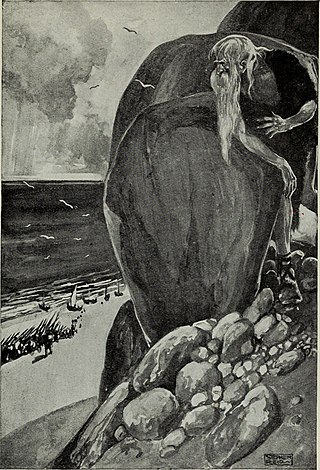
The Fomorians or Fomori are a supernatural race in Irish mythology, who are often portrayed as hostile and monstrous beings. Originally they were said to come from under the sea or the earth. Later, they were portrayed as sea raiders and giants. They are enemies of Ireland's first settlers and opponents of the Tuatha Dé Danann, the other supernatural race in Irish mythology; although some members of the two races have offspring. The Tuath Dé defeat the Fomorians in the Battle of Mag Tuired. This has been likened to other Indo-European myths of a war between gods, such as the Æsir and Vanir in Norse mythology and the Olympians and Titans in Greek mythology.

Nemed or Nimeth is a character in medieval Irish legend. According to the Lebor Gabála Érenn, he was the leader of the third group of people to settle in Ireland: the Muintir Nemid, Clann Nemid or "Nemedians". They arrived thirty years after the Muintir Partholóin, their predecessors, had died out. Nemed eventually dies of plague and his people are oppressed by the Fomorians. They rise up against the Fomorians, attacking their tower out at sea, but most are killed and the survivors leave Ireland. Their descendants become the Fir Bolg.

In medieval Irish myth, the Fir Bolg are the fourth group of people to settle in Ireland. They are descended from the Muintir Nemid, an earlier group who abandoned Ireland and went to different parts of Europe. Those who went to Greece became the Fir Bolg and eventually return to Ireland, after it had been uninhabited for many years. After ruling it for some time and dividing the island into provinces, they are overthrown by the invading Tuatha Dé Danann.

Lebor Gabála Érenn, Modern Irish spelling: Leabhar Gabhála Éireann) known in English as The Book of Invasions, is a collection of poems and prose narratives in the Irish language intended to be a history of Ireland and the Irish from the creation of the world to the Middle Ages. There are a number of versions, the earliest of which was compiled by an anonymous writer in the 11th century. It synthesised narratives that had been developing over the foregoing centuries. The Lebor Gabála tells of Ireland being settled six times by six groups of people: the people of Cessair, the people of Partholón, the people of Nemed, the Fir Bolg, the Tuatha Dé Danann, and the Milesians. The first four groups are wiped out or forced to abandon the island; the fifth group represents Ireland's pagan gods, while the final group represents the Irish people.

Cath Maige Tuired is the name of two saga texts of the Mythological Cycle of Irish mythology. It refers to two separate battles in Connacht: the first in the territory of Conmhaícne Cúile Tuireadh near Cong, County Mayo, the second near Lough Arrow in County Sligo. The two texts tell of battles fought by the Tuatha Dé Danann, the first against the Fir Bolg, and the second against the Fomorians.
Túathal Techtmar, son of Fíachu Finnolach, was a High King of Ireland, according to medieval Irish legend and historical tradition. He is said to be the ancestor of the Uí Néill and Connachta dynasties through his grandson Conn of the Hundred Battles. The name may also have originally referred to an eponymous deity, possibly even a local version of the Gaulish Toutatis.
In Irish mythology Eochaid, son of Erc, son of Rinnal, of the Fir Bolg became High King of Ireland when he overthrew Fodbgen. He was the first king to establish a system of justice in Ireland. No rain fell during his reign, only dew, and there was a harvest every year.

The Connachta are a group of medieval Irish dynasties who claimed descent from the legendary High King Conn Cétchathach. The modern western province of Connacht takes its name from them, although the territories of the Connachta also included at various times parts of southern and western Ulster and northern Leinster. Their traditional capital was Cruachan.
Rudraige may refer to:
Sengann is the name of two early settlers of Ireland according to Irish mythology.
In Irish mythology Fiacha Cennfinnán, son of Starn, son of Rudraige, of the Fir Bolg, became High King of Ireland when he overthrew his great-uncle Sengann.
In Irish mythology, Rinnal son of Genann of the Fir Bolg became High King of Ireland when he overthrew Fiacha Cennfinnán. He is said to have been the first king in Ireland to use spearheads.
In Irish mythology Fodbgen or Odbgen son of Sengann of the Fir Bolg became High King of Ireland when he overthrew his cousin Rinnal son of Genann. It is said that before his time there were no knots in trees.
Sláine, son of Dela, of the Fir Bolg was the legendary first High King of Ireland, who cleared the forest around Brú na Bóinne. He reportedly came ashore at Wexford Harbour at the mouth of the River Slaney.
Rudraige, son of Dela, of the Fir Bolg was the legendary second High King of Ireland, succeeding his brother Sláine.
Gann, son of Dela, of the Fir Bolg was a legendary joint High King of Ireland with his brother Genann, succeeding their brother Rudraige. His wife was Etar.
Sengann, son of Dela, of the Fir Bolg, was a legendary High King of Ireland, succeeding his brothers Gann and Genann. His wife was Anust.
Rudraige mac Sithrigi, was, according to medieval Irish legend and historical tradition, a High King of Ireland. The son of Sitric, he took power after killing his predecessor, Crimthann Coscrach, and ruled for thirty or seventy years, after which he died of plague in Airgetglenn. He was succeeded by Finnat Már, son of Nia Segamain. He is the ancestor of Clanna Rudraige.
Mac Dela is an Irish surname, and may refer to: